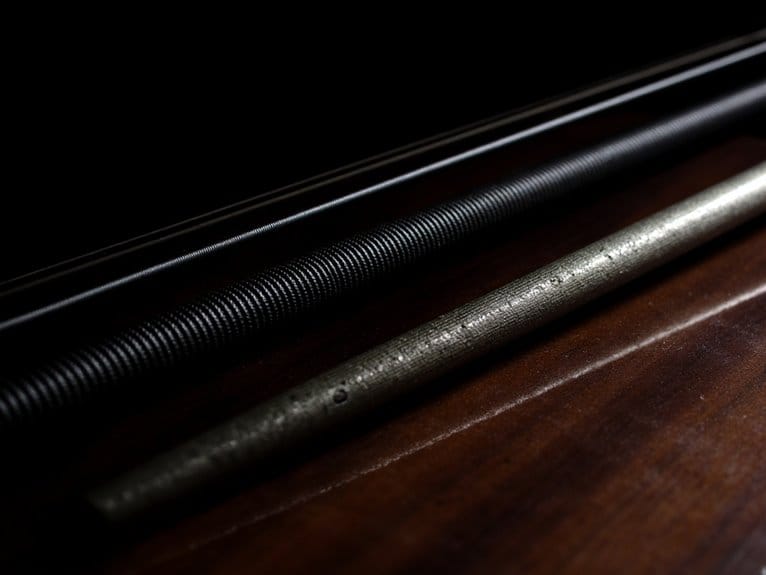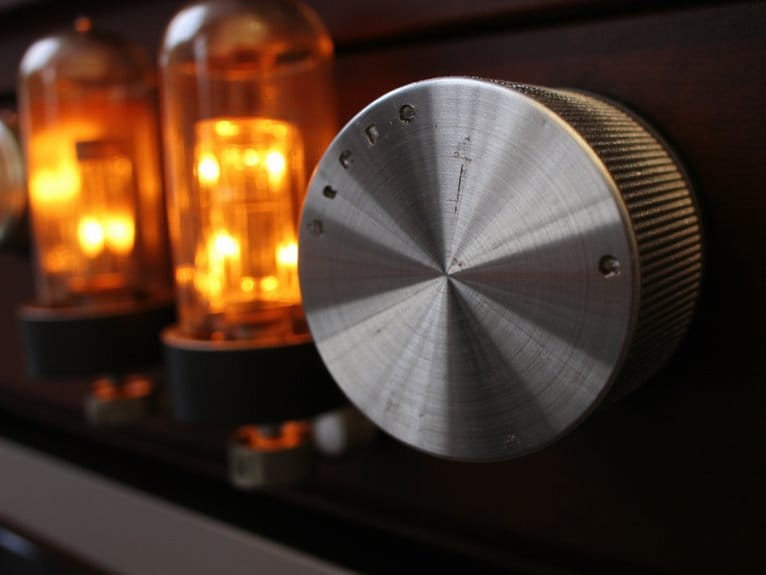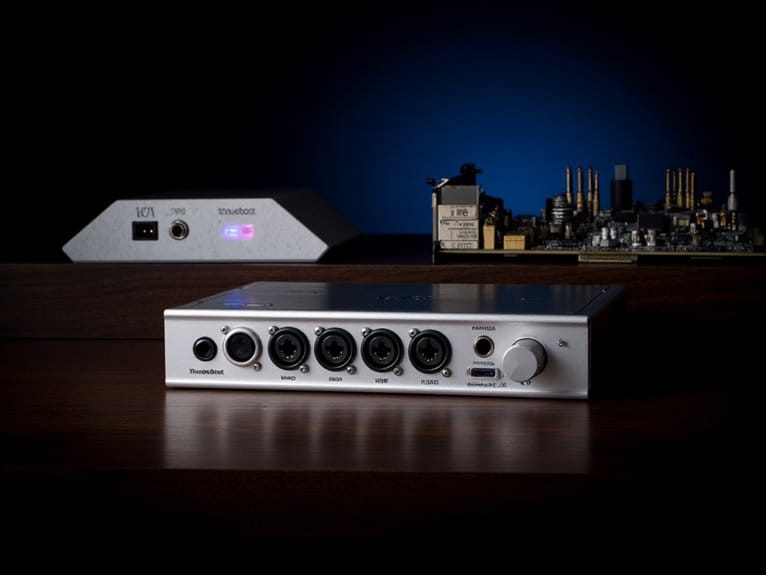Understanding Guitar Bridge Types and Their Impact on Sound
Your guitar’s bridge type dramatically affects your instrument’s sound, sustain, and playability through vibration transfer and mechanical properties. Fixed bridges like Tune-O-Matic designs maximize sustain and tuning stability by efficiently conducting string vibrations, while tremolo systems sacrifice some sustain for expressive pitch manipulation capabilities. Bridge materials matter too—brass and steel saddles deliver warmer tones with enhanced sustain, whereas aluminum components produce brighter sounds. Each design serves specific genres and playing styles, from jazz’s stability requirements to metal’s aggressive techniques that demand specialized features.
We are supported by our audience. When you purchase through links on our site, we may earn an affiliate commission, at no extra cost for you. Learn more.
Notable Insights
- Fixed bridges provide superior sustain and tonal focus through efficient vibration transfer to the guitar body.
- Tremolo bridges sacrifice some sustain for pitch manipulation capabilities, absorbing vibrational energy during use.
- Bridge materials significantly affect tone: brass/steel saddles create warmer sounds while aluminum produces brighter tones.
- Floating bridge systems offer expressive versatility but require complex setup and frequent tuning compared to fixed bridges.
- Bridge choice should match playing style: fixed bridges excel for jazz/blues while tremolos suit rock/metal genres.
Bridge Categories and Basic Types
The foundation of guitar tone and playability rests greatly on bridge design, where two primary categories dominate the landscape: fixed bridges that anchor solidly to the guitar body without movement, and floating bridges that incorporate tremolo systems for pitch manipulation.
When you’re examining this bridge classification overview, you’ll discover that fixed bridges deliver superior vibration transfer to the guitar body, creating enhanced sustain and more focused tonal output. The fixed bridge advantages become apparent through their straightforward maintenance requirements and reliable tuning stability. Resonator guitars utilize specialized biscuit bridge designs that work in conjunction with metal cones to amplify and project sound naturally.
Floating bridges, conversely, offer expressive pitch modulation through tremolo arms, though they typically require more complex setup procedures. These bridges are designed to float above the guitar’s surface using two pivoting points, allowing for the characteristic pitch manipulation effects. Heavy brass or steel blocks enhance sustain and tone compared to zinc alloy, which may lack the desired sonic depth of more substantial materials. It’s important to understand that all guitars require some form of bridge system, as no functional bridgeless guitar exists. When recording guitars, many professionals prefer using audio interfaces with ultra-low latency performance to ensure tight recordings without audio delays. Your choice between these fundamental categories will greatly influence your instrument’s sonic character, sustain properties, and overall playing experience.
Impact on Tuning Stability
When you’re selecting a bridge for your guitar, tuning stability becomes one of the most critical factors that’ll determine whether you spend more time playing or constantly retuning between songs.
| Bridge Type | Tuning Stability |
|---|---|
| Fixed/Hardtail | Excellent – minimal movement |
| Tremolo (vintage) | Poor – requires frequent retuning |
| Locking Tremolo | Good – mitigates tuning loss |
| Roller Saddle | Very Good – reduced friction |
Fixed bridges like Telecaster hardtails offer superior stability through rigid construction, while tremolo systems introduce tuning compromises due to their floating design. Bridge comparisons reveal that roller saddles notably improve tuning retention by reducing string binding, especially beneficial for vibrato use. The bridge plays a decisive role in the overall playability of the instrument, making it essential to match your bridge choice with your playing style and performance requirements. Specialized systems like Evertune provide near-perfect stability through mechanical tension compensation, though they require adjusted playing techniques for ideal performance. Just as audio equipment requires proper connection types for optimal performance, guitar bridges need appropriate setup and maintenance to achieve their maximum tuning stability potential. Similar to how four-conductor wiring in guitar pickups enables greater functionality and customization options, advanced bridge designs often incorporate additional features that enhance overall guitar versatility. Recording guitarists often benefit from plug-and-play connectivity when integrating their instruments with modern audio interfaces and mobile devices.
Influence on Sustain and Tone
While tuning stability affects how often you’ll reach for your tuner, the bridge’s impact on sustain and tone shapes the very character of your sound, influencing everything from how long your notes ring out to the fundamental voice of your instrument.
Different bridge designs create distinct tonal signatures through their construction and mechanical properties. Fixed bridges like the Tune-O-Matic anchor strings directly to your guitar’s body, maximizing vibration transfer and delivering enhanced sustain that’s particularly noticeable during melodic solos and power chord progressions.
Here’s how bridge materials affect your sound:
- Brass and steel saddles provide warmer, fuller tones with improved sustain
- Aluminum components offer brighter characteristics with moderate sustain retention
- Solid metal construction enhances tonal clarity through efficient vibration conduction
Tremolo systems sacrifice some sustain for expressive capabilities, as their moving parts absorb vibrational energy that would otherwise extend note duration. Bridge construction quality becomes especially critical when considering extended range guitars, where solid design ensures consistent performance across all seven strings and helps maintain tuning stability under the increased string tension.
Budget-conscious players can still achieve excellent sustain and tone quality, as many quality construction guitars under $300 feature solid wood components like mahogany and basswood that enhance vibration transfer and overall sound characteristics. Similar to how split-coil pickups deliver warm, versatile tones across various music genres, your bridge choice significantly influences your guitar’s fundamental voice and resonance capabilities.
Adjustability and Setup Flexibility
Four fundamental adjustment capabilities separate basic bridges from precision instruments, and understanding these differences can dramatically impact your guitar’s playability and performance.
Tune-O-Matic bridges offer individual saddle customization through independent height and intonation adjustments, allowing you to dial in precise string action and perfect pitch accuracy for each string. Nashville variants include thumbwheels for easy height changes, while ABR-1 models use threaded posts with thumbscrews for more traditional adjustment methods.
Bridge variations range from simple wraparound designs that prioritize raw tone over flexibility, to complex hardtail systems supporting everything from basic setups to tremolo conversion kits.
I’ve found that more adjustment points mean greater setup complexity, requiring experienced hands, but the payoff in personalized playability makes the extra effort worthwhile for serious players. Just as oxygen-free copper conductors ensure clean signal transmission in quality cables, proper bridge materials and construction directly affect how your guitar delivers its signal to your amplifier.
Similar to how budget guitars often require setup adjustments for optimal performance, bridge selection and proper adjustment can transform an instrument’s playability regardless of its price point.
Ease of Maintenance and Restringing
When you’re choosing a guitar bridge, you’ll quickly discover that maintenance complexity varies greatly between simple fixed bridges that allow straightforward string changes, and intricate locking systems like Floyd Rose tremolo bridges that require specialized tools and considerably more time for basic restringing tasks.
I’ve found that while fixed bridges typically involve threading strings through the body or bridge posts and tuning up, locking mechanisms demand disengaging clamps at both the nut and bridge, adding multiple steps that can turn a five-minute string change into a twenty-minute ordeal.
Beyond routine maintenance, you should also consider that some bridge types may eventually require complete replacement due to wear on knife-edge pivots, springs, or locking mechanisms, which can involve considerable costs and professional setup work. Most modern replacement bridges feature drop-in designs requiring no permanent modifications, with installation typically completed in 5-20 minutes using included tools.
Similarly, acoustic guitarists often face maintenance decisions when selecting acoustic pickups, as battery-powered systems require regular power management while passive designs eliminate battery maintenance concerns entirely.
Simple Restringing Processes
One of the most practical considerations I’ve learned through years of guitar maintenance is that restringing ease varies dramatically between bridge types, and honestly, this difference can make or break your relationship with regular string changes.
I’ve found that certain stringing techniques work better with specific bridge designs, and maintaining proper bridge alignment saves considerable headaches. For electric guitars, the process typically involves straightforward string posts, while acoustics require careful bridge pin seating.
Here’s my simplified restringing approach:
- Use proper tools – string winders, wire cutters, and clip-on tuners accelerate the process greatly
- Create strategic bends – 45° angles and Z-shapes at string ends prevent slippage during winding
- Control slack carefully – four finger widths between nut and bridge balances tension while maintaining easy handling
For beginners or those with smaller hands, nylon strings are particularly recommended as they’re gentler on fingers and require less tension during the restringing process.
The gauge selection you choose will also impact the restringing process, as lighter gauges are more forgiving during installation and require less effort to achieve proper tension.
Additionally, ensuring proper nut width compatibility prevents binding issues that can complicate the restringing process and affect overall playability.
These methods consistently deliver stable tuning with minimal frustration.
Complex Locking Mechanisms
While the simple restringing methods I’ve outlined work wonderfully for standard bridges, locking technology presents an entirely different challenge that honestly intimidated me when I first encountered them.
These double-locking systems clamp strings at both bridge saddles and nuts, delivering exceptional string stability and tuning accuracy through aggressive tremolo functionality, but they’ll demand specialized tools like Allen wrenches and considerable patience during maintenance challenges.
You’ll need to replace strings incrementally to preserve tremolo balance, cut ball ends before insertion, and navigate multiple locking points with adjustment precision that requires careful attention to wear considerations. Unlike high-output pickups that maintain clarity under extreme conditions, locking bridges require meticulous setup to avoid performance issues during aggressive playing.
Despite increased complexity, performance reliability remains unmatched for demanding playing styles requiring extreme pitch manipulation. Similar to how dual-channel setups allow simultaneous connections for multiple instruments, complex bridge systems require multiple adjustment points to achieve optimal performance.
Just as audio interfaces require careful attention to input connections and signal routing for optimal sound quality, the precise setup of locking bridge systems determines whether your instrument will perform reliably during demanding musical applications.
Bridge Replacement Requirements
Beyond the specialized challenges of locking systems, the broader landscape of bridge replacement and maintenance requirements varies dramatically based on fundamental design philosophy, with fixed bridges offering the most straightforward ownership experience while tremolo systems demand increasingly sophisticated upkeep routines.
Your bridge lifespan directly correlates with design complexity, where I’ve observed that replacement frequency follows predictable patterns:
- Fixed bridges typically last decades with minimal intervention, requiring replacement only after severe wear or damage.
- Tremolo systems need component replacement every 2-5 years depending on usage intensity and maintenance quality.
- Locking mechanisms demand the most frequent service, with springs and pivot points requiring attention annually.
Understanding these maintenance cycles helps you budget appropriately and choose bridges that match your commitment level to ongoing upkeep.
Genre and Playing Style Suitability
When I’ve guided countless guitarists through bridge selection over the years, I’ve consistently found that understanding the relationship between bridge types and specific genres can dramatically transform your playing experience and sound quality.
Tremolo versatility shines in rock, metal, and surf music where pitch modulation creates signature sounds, while fixed bridge advantages become apparent in jazz, blues, and country where tuning stability matters most.
Your genre selection should directly influence bridge choice—Floyd Rose systems excel for aggressive metal playing techniques, synchronized tremolos suit expressive blues work, and Tune-O-Matic bridges deliver the sustain jazz players crave.
Multi-scale bridges have revolutionized progressive metal and djent, optimizing string tension for extended-range instruments and complex alternate tunings that define these evolving genres.
Fixed bridges enhance tuning stability over floating designs while providing improved sustain characteristics, making them particularly suitable for players who prioritize reliability in their performance setup.
Frequently Asked Questions
Can I Convert My Guitar From One Bridge Type to Another?
You can convert your guitar’s bridge type, but it’ll require body modifications, routing, and potentially significant costs. Each bridge type affects tone difference, sustain, and playability, so consider these factors carefully.
How Much Do Different Bridge Types Typically Cost to Purchase and Install?
Bridge type prices vary considerably: fixed bridges cost $20-$200, tremolo systems run $70-$350, while specialty bridges like Evertune reach $810. Installation costs add $50-$200 depending on complexity and required modifications.
On a final note
You’ll find that choosing the right bridge isn’t just about aesthetics—it fundamentally shapes your guitar’s voice, playability, and maintenance requirements. Whether you’re drawn to the vintage warmth of a wraparound, the versatility of a tune-o-matic, or the expressive potential of a Floyd Rose, each design offers distinct advantages that’ll complement specific playing styles. Consider your musical priorities, technical skills, and genre preferences when making this essential decision.






